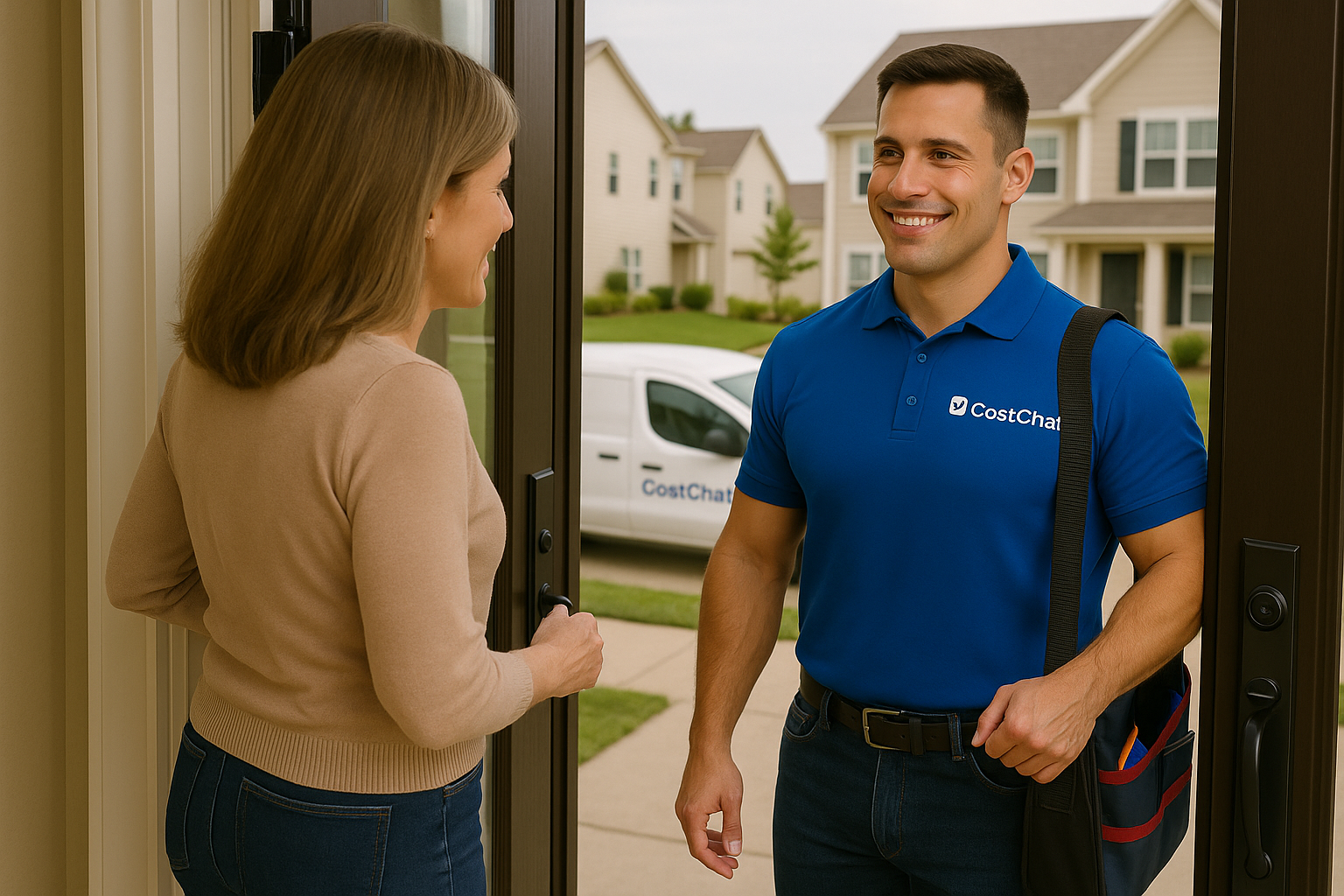
Trusted Emergency Plumbing Experts Near You in Sacramento, CA
How to Hire Top Rated Emergency Plumbing Pros in Sacramento, CA
Get a Free Online Estimate
Share your project details and receive a free online estimate from top-rated local pros. Not sure what it should cost? Check our Cost Guide.
Get EstimateCompare Local Quotes
View multiple free online quotes side by side. Use our Price Guide to understand labor rates, materials, and service fees before you hire.
Compare NowBook Best Top Rated Pros
Choose a licensed pro with confidence. Lock in your date after reviewing your free estimate and browsing our expert Cost Guide for peace of mind.
Book NowDid You Know?
74% ⚠️
of homeowners face surprise costs and delays — mostly from hiring unvetted pros. Don’t risk it. Hire trusted experts today.
Hire Top Rated & Verified ProsWork With Verified & Trusted Pros 🛡️
Save time, avoid costly mistakes, and experience reliable, top-quality service for every home project. Book now for priority scheduling and peace of mind.
Hire a Top Rated ProGet Instant Online Estimate of Emergency Plumbing in
🔎 CostChat Online Cost Estimator
Describe your project and location to get an instant estimate.
Emergency Plumbing in Sacramento, CA: Your Ultimate Homeowner's Guide
Experiencing a plumbing emergency in Sacramento, CA, can be incredibly stressful. From sudden leaks to overflowing toilets, these issues disrupt your home's comfort and can lead to significant damage if not addressed promptly. As homeowners in the capital city, understanding the nuances of our local infrastructure, climate, and regulations is key to navigating these emergencies effectively. This guide is designed to provide you with comprehensive, localized information to help you make informed decisions when you need emergency plumbing services in Sacramento.
Table of Contents
- Sacramento, CA's Unique Emergency Plumbing Landscape: Why Local Expertise Matters
- Neighborhood Hotspots: Micro-Local Emergency Plumbing Risks & Solutions
- Common Problems & Triggers for a Professional Emergency Plumbing Call
- Navigating Sacramento, CA's Regulations: Permits, Code & Professional Licensing
- Maximize Your Savings: Sacramento, CA Emergency Plumbing Rebates & Incentives
- Choosing Your Sacramento, CA Emergency Plumbing Component: Models, Sizing & Smart Features
- The Cost of Emergency Plumbing in Sacramento, CA
- Hiring Sacramento, CA's Top-Rated Emergency Plumbing Professional: Your Action Plan
- FAQs About Emergency Plumbing in Sacramento, CA
Sacramento, CA's Unique Emergency Plumbing Landscape: Why Local Expertise Matters
The Age & Character of Sacramento, CA Homes: A Emergency Plumbing-Related Time Capsule
Sacramento, with an estimated 2025 population of 526,954 and a metro area exceeding 2.2 million, boasts a rich architectural history reflected in its diverse housing stock. This history directly impacts the types of plumbing challenges homeowners encounter. Approximately 100 square miles of the city feature neighborhoods with homes built across various eras, many of which were constructed mid-20th century or earlier, often exceeding 50 years in age.
- Mid-20th Century Homes (and earlier): Found in historic areas like Curtis Park, Land Park, and Oak Park, these homes often showcase styles such as Craftsman bungalows, Tudor Revival, and Spanish Colonial Revival. A significant challenge here is the prevalence of galvanized steel pipes, common in homes built before the 1960s. These pipes tend to corrode internally over time, reducing water flow and increasing the risk of leaks and bursts. Additionally, cast iron drains and vent stacks can deteriorate, leading to blockages or the emission of sewer gas odors.
- Mid-to-Late 20th Century Homes: Many suburban developments feature ranch-style homes from this period. While some may have been updated, others might still contain original plumbing components that are nearing the end of their lifespan.
- Modern Construction: Newer areas incorporate contemporary and ranch-style homes. While generally built with more modern materials, these homes are not immune to issues, especially if installation was subpar or if they've been subject to local environmental stressors.
The aging infrastructure in older Sacramento homes is a primary driver for many emergency plumbing situations. Remodeling efforts can often uncover outdated plumbing that requires comprehensive upgrades to meet current codes and ensure reliability. Furthermore, Sacramento's geographic location means its plumbing systems are susceptible to stresses from periodic soil shifts, potentially causing pipe bellies or joint separations, and in some cases, leading to slab leaks—water leaks beneath concrete foundations.
Emergency Plumbing's Environmental & Utility Factors & Climate Impact on Your Plumbing System
Understanding Sacramento's environment is crucial for maintaining your plumbing system and preventing emergencies.
- Water Source and Quality: The City of Sacramento Department of Utilities sources water primarily from the Sacramento and American Rivers. While water quality generally complies with federal and state standards, the presence of minerals, particularly in hard water conditions, can contribute to scale buildup within pipes and fixtures. This buildup can restrict water flow, reduce the efficiency of water heaters, and eventually lead to pipe blockages or failures. You can find more information at sacwaterquality.com.
- Climate Influence: Sacramento experiences a Mediterranean climate characterized by hot, dry summers and wet winters. While freezing is rare, soil conditions and fluctuating water tables can cause ground movement.
- Drought Conditions: Prolonged dry periods emphasize water conservation efforts and can concentrate minerals in the water supply, potentially exacerbating scale buildup and pipe corrosion.
- Occasional Heavy Rains: Wet winters and heavy rainfall can increase the risk of flooding in low-lying areas, which can impact the functionality of underground sewer and drain systems, leading to backups and overflows.
- Seismic Activity: While not as high-risk as some coastal California regions, Sacramento is in an area prone to seismic activity. Earth movements and periodic soil shifts can exert stress on underground plumbing, increasing the likelihood of leaks and pipe damage.
These environmental factors necessitate proactive plumbing maintenance and the use of durable materials like copper or PEX piping for replacements and upgrades to ensure long-term reliability.

Don't wait for a minor drip to turn into a major emergency. Get reliable service when you need it most.
Request ServiceNeighborhood Hotspots: Micro-Local Emergency Plumbing Risks & Solutions
Sacramento's diverse neighborhoods present unique plumbing challenges due to variations in age, construction, and local environmental factors. Understanding these micro-local risks can help you anticipate potential problems.
- Curtis Park & Land Park: These historic neighborhoods, known for their beautiful Craftsman and Spanish Colonial Revival homes, often feature older plumbing systems. Expect potential issues with corroded galvanized pipes, aging drain lines, and the possibility of slab leaks due to the age of the infrastructure and underlying soil conditions. Solution: Consider a proactive whole-house repiping with PEX or copper and ensure regular inspections of sewer lines.
- East Sacramento & Tahoe Park: Similar to Curtis Park, these areas have many homes built from the mid-20th century onwards. Common issues can include worn-out pipe joints, fixture leaks, and water heater failures as these units approach the end of their typical lifespan. Solution: Prioritize water heater maintenance and keep an eye out for early signs of pipe degradation.
- Downtown & Midtown: While often featuring more updated or commercial properties, older residential buildings in these vibrant areas can still house original plumbing, leading to unexpected leaks or fixture malfunctions. Higher density can also mean more stress on shared underground infrastructure. Solution: Regular drain cleaning and prompt attention to any dripping faucets or running toilets are essential.
- Newer Suburban Areas: In more recently developed neighborhoods, the primary concerns might stem from improper installation, seismic stress on underground pipes, or issues arising from rapid expansion and soil settlement. Solution: Ensure all work is performed by licensed professionals and that any signs of foundation stress are investigated promptly.
Knowing these neighborhood-specific vulnerabilities allows for more targeted preventative maintenance and quicker identification of problems, reducing the likelihood of a full-blown emergency.
Common Problems & Triggers for a Professional Emergency Plumbing Call
Recognizing the warning signs of plumbing issues is crucial to preventing minor problems from escalating into costly emergencies. Many common triggers are linked to Sacramento's housing stock and environmental conditions.
- Leaky Pipes: This is perhaps the most common emergency. In Sacramento, leaks can originate from corroded galvanized pipes, cracked PEX, or faulty pipe joints stressed by soil movement. Pay attention to discolored water, damp spots on walls or ceilings, or unusually high water bills.
- Clogged Drains and Toilets: While often seen as a nuisance, severe clogs can lead to backups and overflows, especially in older homes with cast iron drain lines. Slow drains, gurgling sounds, and sewage odors are warning signs.
- Running or Leaking Faucets and Toilets: These may seem minor, but they waste significant water and can indicate internal component wear, leading to bigger problems if left unaddressed.
- Water Heater Issues: A failing water heater can lead to no hot water, leaks, or even potentially dangerous gas leaks. For many Sacramento homes, water heaters typically last 8-12 years.
- Slab Leaks: These are particularly problematic in Sacramento homes with concrete foundations. They can be caused by pipe corrosion or seismic soil movement and often manifest as warm spots on the floor, foundation cracks, or unexplained water meter readings.
- Low Water Pressure: This can signal corroded pipes, a partially closed valve, or issues with the municipal water supply, but persistent low pressure might indicate internal pipe blockages.
Early detection is key. For more information on identifying these issues, consult CostChat's Warning Signs Guide. If you encounter a critical plumbing failure, such as a burst pipe or major sewer backup, remember to take immediate action by shutting off the main water supply and calling for emergency assistance. You can learn more about handling emergencies at What to Do in a Plumbing Emergency.
Navigating Sacramento, CA's Regulations: Permits, Code & Professional Licensing
Ensuring your plumbing work complies with local and state regulations is vital for safety, property value, and avoiding future issues. Sacramento follows stringent guidelines to protect homeowners and maintain public infrastructure.
- Permitting Process: For major plumbing projects such as repiping, water heater replacement, or significant fixture installations, a plumbing permit is typically required. The Sacramento Department of Community Development (Building Division) oversees this process. You can find information and initiate permit applications through their website: cityofsacramento.org/Community-Development/Building.
- Governing Code: Sacramento adheres to the California Plumbing Code (CPC), which is based on the Uniform Plumbing Code (UPC) with state-specific amendments. These amendments often include provisions for seismic safety and water conservation measures relevant to California's climate and environment.
- Required Inspections: Depending on the scope of work, several inspections may be required by the city to ensure compliance with the CPC and approved plans. These typically include inspections for underground piping, rough plumbing (before walls are closed), and final inspections. Your permit will outline the specific inspections needed for your project.
- DIY vs. Professional Installation: While minor repairs might be feasible for experienced DIYers, most significant plumbing work, especially involving gas lines or major pipe modifications, is best left to licensed professionals. Incorrect installation can lead to leaks, safety hazards, and costly code violations. For guidance on what you can tackle yourself, see CostChat's When to Consider DIY Guide.
- Contractor Licensing: All plumbers working in California must be licensed by the California Contractors State License Board (CSLB). This ensures they meet specific standards of experience, competency, and financial stability. You can verify a contractor's license status online through the CSLB's search tool: cslb.ca.gov. Always ask for the license number and verify it.
Working with licensed and permitted professionals ensures the job is done correctly, safely, and in compliance with all applicable regulations.
Maximize Your Savings: Sacramento, CA Emergency Plumbing Rebates & Incentives
Investing in plumbing upgrades or efficient fixtures can often come with financial incentives. Sacramento offers various programs designed to help homeowners save money while improving their homes' efficiency.
- SacWaterWise Program: Sacramento promotes water conservation through programs like SacWaterWise, which may offer rebates for installing water-efficient appliances, fixtures, and leak detection devices. Check their website for the latest offerings and eligibility criteria: sacwaterwise.com.
- Water Heater Rebates: Look for potential rebates from the City of Sacramento Department of Utilities or state energy programs on the purchase and installation of energy-efficient water heaters, such as those with higher Energy Factor (EF) ratings or tankless models.
- Federal Tax Credits: The Inflation Reduction Act may offer federal tax credits for certain energy-efficient home improvements, which can sometimes include specific types of water heaters or plumbing upgrades.
- Bonus Tip: Strategic timing can maximize savings. Often, rebates are tied to specific program years or may have limited funding. It's wise to research available incentives before beginning a project and to coordinate with your plumber about eligible equipment.
For a comprehensive overview of ways to reduce costs, explore CostChat's Saving Tips Guide.
Choosing Your Sacramento, CA Emergency Plumbing Component: Models, Sizing & Smart Features
When facing plumbing needs, especially emergencies, choosing the right components and ensuring proper sizing and features for your Sacramento home is crucial for performance and longevity.
- Water Heaters: Sacramento homes typically use tank-style gas or electric water heaters. Sizing depends on household demand; a typical 40-50 gallon tank is suitable for most families. Tankless water heaters offer on-demand hot water and energy savings but have a higher upfront cost. Consider models with higher Energy Factor (EF) ratings for better efficiency in Sacramento's climate.
- Pipes: For new installations or repiping, copper and PEX (cross-linked polyethylene) are the standard modern materials. Copper is durable but more expensive and susceptible to freeze damage (less of a concern in Sacramento). PEX is flexible, less expensive, and easier to install, making it a popular choice.
- Fixtures: Low-flow toilets and faucets are recommended to conserve water, especially during Sacramento's dry spells. Look for the WaterSense label for certified efficient products.
- Key Installation Considerations for Sacramento Homes:
- Seismic Bracing: Ensure water heaters and major appliances are properly braced to withstand seismic activity.
- Water Quality: If your home has particularly hard water, consider installing a water softener or using pipe descalers to prevent mineral buildup, especially in water heaters and showerheads.
- Pipe Material History: If your home has older galvanized steel pipes, discuss repiping options with your plumber to avoid potential failures and water quality issues.
- Slab Penetrations: For homes with slab foundations, plumbers must ensure proper sealing and protection where pipes penetrate concrete to prevent future issues.
Always consult with a qualified Sacramento plumber to determine the best components and sizing for your specific home and needs.
The Cost of Emergency Plumbing in Sacramento, CA
Understanding the potential costs associated with emergency plumbing services in Sacramento is essential for budgeting and making informed decisions. Costs can vary significantly based on the nature of the emergency, the time of day, and the complexity of the repair.
- Emergency Service Call Fee: Many plumbers charge a dispatch or emergency service call fee, which can range from $100 to $250. This fee often covers the initial visit and diagnosis.
- Hourly Rates: For labor, expect hourly rates typically ranging from $75 to $150 per hour for a licensed plumber. Work performed during nights, weekends, or holidays will usually incur higher rates (often 1.5x or 2x the standard rate).
- Common Emergency Repairs:
- Burst Pipe Repair: This could range from $250 to $1,000+, depending on the pipe material, location, and extent of the damage.
- Severe Drain Clog/Sewer Backup: Expect costs from $200 to $750 for professional snaking or hydro-jetting, with higher costs for sewer line repairs.
- Water Heater Replacement: A new standard tank water heater installation can cost between $800 and $2,000, including the unit. Tankless models are significantly more expensive.
- Slab Leak Detection and Repair: These are often the most expensive, with costs ranging from $1,000 to $4,000+ due to the labor involved in accessing and repairing leaks beneath the foundation.
- Factors Influencing Cost:
- Time of Service: After-hours emergency calls are more expensive.
- Materials: The cost of pipes, fittings, and replacement parts will add to the total.
- Complexity: Repairs in difficult-to-access areas or those requiring extensive demolition will cost more.
- Neighborhood: While less common for emergency services, some premium neighborhoods might reflect higher service fees.
- Permits: If permits are required for the repair, factor in permit fees (typically $100-$500, depending on project value).
It's crucial to obtain detailed quotes, ideally with a breakdown of labor and materials, before authorizing any work. Remember that the median household income in Sacramento is approximately $83,753, so these costs should be considered within that financial context.
Hiring Sacramento, CA's Top-Rated Emergency Plumbing Professional: Your Action Plan
When an emergency strikes, choosing the right plumber quickly is essential. Follow these steps to ensure you hire a qualified and reliable professional in Sacramento, CA.
- Verify Licensing and Insurance: Always confirm that the plumber is licensed by the California Contractors State License Board (CSLB). Ask for their license number and verify it at cslb.ca.gov. Ensure they are also insured (general liability and workers' compensation) to protect you from damages or injuries.
- Ask Hyper-Local Questions: Tailor your questions to Sacramento's specific environment:
- "Are you familiar with the plumbing infrastructure in older Sacramento neighborhoods like Land Park or Curtis Park?"
- "What are the common causes of slab leaks you see in the Sacramento area?"
- "Do you have experience with the specific water quality or mineral buildup issues common in Sacramento?"
- "Are you up-to-date on the latest California Plumbing Code amendments relevant to Sacramento?"
- Check Local Reviews and Ratings: Look for reviews on Google, Yelp, or local contractor referral sites. Prioritize plumbers with consistent positive feedback regarding responsiveness, professionalism, and quality of work.
- Obtain Multiple Quotes: For non-life-threatening emergencies, try to get quotes from at least two or three different plumbers. Ensure the quotes are detailed, itemizing labor, materials, and any fees.
- Understand the Contract: Insist on a written contract that clearly outlines the scope of work, the total cost, the timeline, warranty information, and payment terms.
- Avoid Common Mistakes: Be wary of extremely low bids, pressure tactics, or contractors who ask for excessive upfront payment. Consult CostChat's Mistakes to Avoid Guide for further advice.
A thorough vetting process, even in an emergency, can save you time, money, and significant headaches down the line.
FAQs About Emergency Plumbing in Sacramento, CA
What are the biggest plumbing risks specific to Sacramento's older homes?
Sacramento's older homes, particularly those built before the 1960s, are susceptible to issues like corroded galvanized steel pipes, which can lead to leaks and reduced water flow. Deteriorating cast iron drain and vent stacks can cause blockages and sewer gas odors. Additionally, these homes are more prone to slab leaks, often caused by aging pipes or soil shifts, which can be challenging and costly to repair.
How does Sacramento's climate affect my plumbing, and what should I do?
Sacramento's Mediterranean climate, with hot, dry summers and wet winters, influences plumbing in a few ways. Droughts can concentrate minerals in water, leading to scale buildup in pipes and fixtures, reducing efficiency and potentially causing clogs. Heavy winter rains can stress drainage systems and increase flood risks in low-lying areas. To combat scale, regular flushing of water heaters and consideration of water softeners can help. Ensuring proper drainage around your foundation is also key during wet periods.



